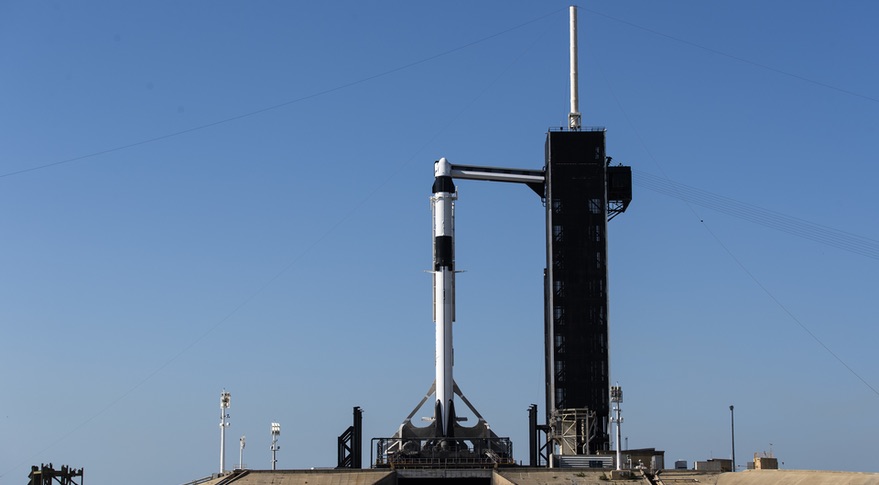Products You May Like
WASHINGTON — As NASA and SpaceX complete final preparations for the first crewed flight of the Crew Dragon spacecraft, the agency is already looking ahead to the spacecraft’s next mission.
Technicians spent the day May 26 wrapping up work ahead of the scheduled 4:33 p.m. Eastern May 27 launch of the Crew Dragon spacecraft on the Demo-2 mission. That included lowering the Falcon 9 rocket from the vertical to horizontal position at Launch Complex 39A for what NASA described as an inspection of a water radiator system used by ground support equipment to keep the spacecraft cool. The work was completed and the rocket returned to the vertical position later in the day.
Meteorologists, as expected, increased the probability of acceptable launch weather from 40% to 60% in a forecast issued early May 26. That forecast, though, does not include weather at abort sites downrange, which could scrub a launch even if weather conditions are acceptable at the launch site.
Despite an audience that will include President Donald Trump and Vice President Mike Pence, NASA Administrator Jim Bridenstine was adamant the agency would not succumb to what’s known as “go fever,” or proceeding with a launch despite safety issues. “This is a serious issue,” he said. “We have to make sure we give permission to say no.”
He argued that desire to ensure people are empowered to speak up is one reason NASA finalized a deal with Roscosmos earlier in the month for a Soyuz seat on a mission launching in October, an agreement that will cost NASA more than $90.2 million. “We want people to feel free to say no, and not feel any pressure to go on this launch.”
Assuming there are no issues that halt the launch, astronauts Bob Behnken and Doug Hurley will wake up around 9 a.m. Eastern on launch day, said Norm Knight, deputy director for flight operations at the Johnson Space Center, during a May 25 briefing. They’ll go through medical checks, have breakfast and get final briefings before suiting up and departing the operations building shortly after 1 p.m. Eastern.
The astronauts will travel to the pad in Tesla Model X electric cars adorned with both NASA’s “meatball” and “worm” logos, the latter brought out of a nearly three-decade retirement specifically for this mission. By about 2 p.m. Behnken and Hurley will enter the Crew Dragon spacecraft. Launch controllers will give final approval 45 minutes before the scheduled 4:33 p.m. liftoff to proceed with fueling of the Falcon 9 rocket.
Demo-2 is designed to be a test flight to confirm the performance of the spacecraft, and was originally intended to spend only a couple weeks in space. However, facing a shortfall in crew on the International Space Station, NASA has decided to extend the mission by a length yet to be determined to allow Behnken and Hurley to assist the one NASA astronaut currently there, Chris Cassidy.
“Remember, this is a test flight. The highest priority is to test the vehicle and get it home safely, and be prepared to launch Crew-1,” Bridenstine said. Crew-1 is the designation for the first operational Crew Dragon mission, which will send three NASA astronauts and one Japanese astronaut to the station.
Bridenstine revealed at the May 26 briefing that NASA is currently targeting an Aug. 30 launch for Crew-1, a date that depends on when the Crew Dragon spacecraft for that mission is ready. The Demo-2 mission will have to return several weeks before that launch date so it can be inspected and the spacecraft certified by NASA for operational missions before Crew-1 can launch.
“They can be there probably until early August,” Bridenstine said of the Demo-2 mission. The specific length of the mission will depend on the performance of the Demo-2 spacecraft, launch readiness for the Crew-1 mission and weather conditions at the splashdown location in the Atlantic Ocean off the Florida coast. “If we have a good window to come home and they are not necessary on the International Space Station, we will be taking it.”
“There is a lot of flexibility built into the back end of the mission, but that’s intentional,” he said, referring to the uncertain length of the Demo-2 mission. “The goal is to get them to the International Space Station, test the systems and get them home. If they can do more work than that while they’re on the ISS, certainly that’s OK. But this is a test flight.”
